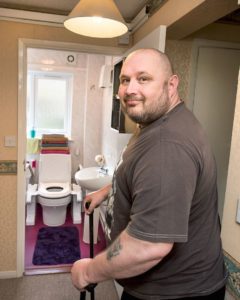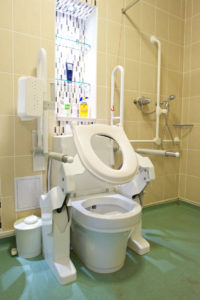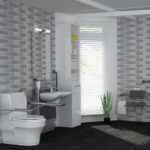Robin Tuffley from Closomat discusses home adaptations and reinforces the importance of ensuring rooms are not just accessible but useable.
Put yourself in your client’s shoes. No one chooses to be disabled; of the 11+million registered disabled people in the UK, only 20% were born with their disability. So it could happen to you. In delivering home adaptations, there is a tendency to forget that, as a specific criterion under the Disabled Facilities Grant, people should be able to access the bedroom, kitchen and toilet, however, there is no point providing access if they still cannot use the room.
Accessibility and useability
Foundations, the national body for Home Improvement Agencies (HIAs) and the lead on transformation of Disabled Facilities Grants (DFGs) points out in its review of the DFG that one in 10 people say they either unable, and find it difficult, to move, stand or walk independently.
Officers tasked with addressing disability in adaptations — whether private or social housing — need to address not just how to empower someone to get into the space, but how they can use it. The ‘how they can use it’ goes beyond the obvious. Kitchens and bathrooms have to be kept clean for hygiene and safety reasons.
 Chris Sneddon, Project Co-Ordinator for the Accessible Homes Agency and Handy Person Service at Calderdale Council, made a great point. Chris explains: “What about the warranty with some of the independent living aids and adaptative equipment? The small print can require specific ancillaries to be used or procedures to be followed yet our clients may not be in a position to do that. If it breaks and the warranty has been invalidated, I am faced with having to buy a new one, with all the stress and inconvenience to the client, and the time my team will have to spend organising the replacement, arranging a contractor to install it etc.”
Chris Sneddon, Project Co-Ordinator for the Accessible Homes Agency and Handy Person Service at Calderdale Council, made a great point. Chris explains: “What about the warranty with some of the independent living aids and adaptative equipment? The small print can require specific ancillaries to be used or procedures to be followed yet our clients may not be in a position to do that. If it breaks and the warranty has been invalidated, I am faced with having to buy a new one, with all the stress and inconvenience to the client, and the time my team will have to spend organising the replacement, arranging a contractor to install it etc.”
As a result, Chris chooses to specify and install solutions that are not so stringent in warranty terms. He addresses best value — which is a duty, an obligation for local authorities to consider.
Duty of Best Value
Under the Duty of Best Value, authorities should consider overall value, including economic, environmental and social value, when reviewing service provision. As a concept, social value is about seeking to maximise the additional benefit that can be created by procuring or commissioning goods and services, above and beyond the benefit of merely the goods and services themselves.
Time and again, a well-thought through adaptation is proven to enable the person to remain in their own home and continue to do activities of daily living (ADLs) for themselves, safely. That has numerous impacts through to demand on social care and health services: grab rails in the bathroom, or replacement of a shower tray with a level access shower, can reduce risk and incidence of falls, for example.
Ask the right questions to get the right solutions
Getting an adaptation right depends on the right questions being asked in the first place. In the kitchen, it is a little easier, as recipients will more willingly admit that they struggle to lift the kettle from a conventional height worktop. In the bathroom, it is harder: would you admit to a stranger you cannot get on and off the WC? That you are struggling to wipe your bottom? That you cannot get out of the bath?
Depending on the bathroom layout, the client may well be improvising and using the basin — if within reach — as leverage and support. However, the basin was not designed for that, and may well not be fixed securely enough.
Asked if they struggle to get in and out of the chair in the lounge, most clients will answer that happily. That lends itself to be asked the follow-on question of how do they manage in the bathroom. Then you can deliver an adaptation that is necessary and appropriate, that is reasonable and practical — from the outset, which future-proofs the home for at least the short to medium-term (again, helping deliver good practice duty).
 Client choice
Client choice
Also, the client should have choice. A raised toilet seat may well make it difficult for the rest of the household to use the WC. It may make the client feel unbalanced, unsafe when they are using the WC, especially as they reach or contort to wipe themselves.
A toilet lifter — the WC equivalent of a riser recliner chair — may be a better solution. Or an alternative WC, such as a wash and dry toilet, that can be set to the most appropriate height for the user and spare them having to risk the contortion and balance issues inherent in wiping. Both pieces of equipment are conventionally perceived to form major adaptations, but in reality are simple and straightforward to install, helping accelerate delivery.
If funded under a DFG, the additional cost is almost an irrelevance. It is not the Council’s pot of money, but Government funding. Depending on where the Authority pitches its means testing, such adaptations can be done expediently as a ‘fast track’. The process can be accelerated further.
Speeding up the assessment processes
If a Regulatory Reform Order (RRO) is implemented, that can in effect throw out the rulebook for DFG applications. RROs can be used to remove means testing, to expedite hospital discharge adaptations, and execute preventative adaptations. Under such orders, equipment bought to enable one client can be repurposed to help another (recycled) when no longer needed. Indeed, some equipment manufacturers offer recycling schemes now, whereby they will clean and recondition the kit before sending it out to its new location.
There is also growing use of product specialists and trusted assessors, whereby those with the detailed knowledge can work alongside the adaptations team to get the equipment specification right from the outset. Then a disabled adaptation that meets the need is achieved.









